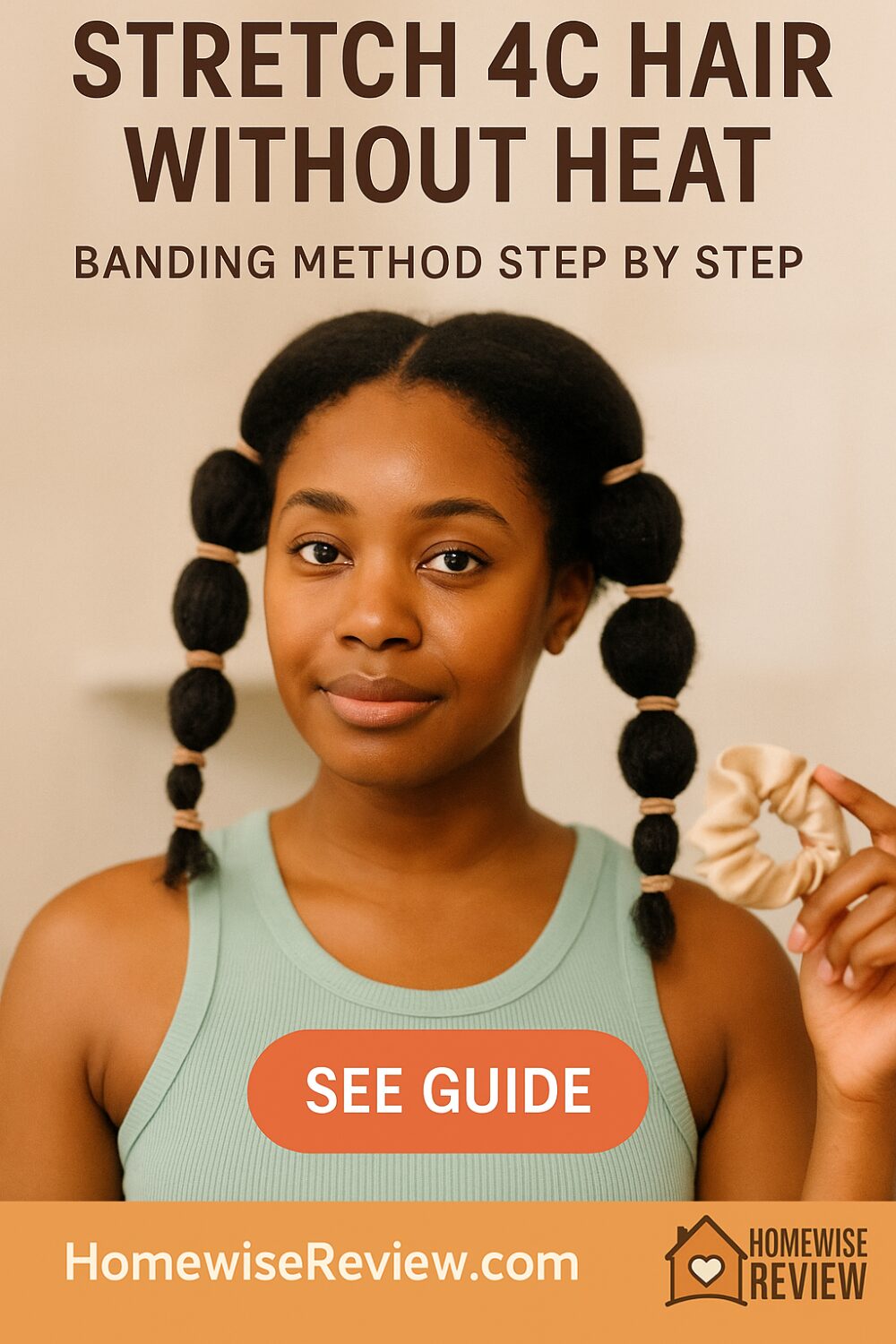
What banding does and why it helps 4C hair
Banding is a no-heat technique that keeps curls elongated while they dry. You section damp hair, smooth a leave-in, then wrap snag-free bands down each section to hold shape. Less shrinkage means easier detangling, fewer knots, and more versatile styling the next day. It works because controlled tension plus product slip reduces coil spring-back while the cuticle settles.
Quick comparison of no-heat stretching methods
| Method | Stretch level | Time to set | Best for |
|---|---|---|---|
| Banding | High, customizable by spacing | Moderate | Next-day braid outs, twist outs, updos |
| Two-strand twists | Medium | Fast | Defined spirals with light stretch |
| Braids/plaits | Medium-high | Moderate | Tidy stretch with longer wear |
| African threading | Very high | Long | Maximum stretch with sleek results |
Supplies checklist
- Snag-free covered elastics or spiral ties. Avoid rubber bands.
- Wide-tooth comb or detangling brush for slip only, not force.
- Leave-in conditioner for slip, light cream for moisture, light oil or serum to seal.
- Clips to park sections, satin scarf or bonnet.
Prep: get the starting canvas right
- Cleanse and condition. Hair stretches more evenly when buildup is gone. Choose a sulfate-free shampoo that still cleans and a conditioner with good slip.
- Detangle on drenched hair. Work in sections from ends to roots with conditioner on. Rinse cool.
- Blot, do not rub. Use a T-shirt or microfiber towel until hair is damp, not dripping.
Step-by-step banding for 4C hair
- Section for control
- Part hair into 4 to 8 sections depending on density. More sections mean faster drying with less tension. Clip away what you are not working on.
- Prime each section
- Work a quarter-size amount of leave-in through from ends up. Add a pea-size cream if you run dry. Seal lightly with a few drops of oil, focusing on ends.
- Create your base pony
- Gather the section into a low-tension ponytail at the root using a snag-free band. Do not pull tight. You should feel secure but comfortable.
- Band down the length
- Add bands every 1 to 1.5 inches for maximum stretch. For a softer, fuller result, space bands 2 inches apart. Keep tension even. Do not overlap bands.
- Set and dry
- Air dry fully. You can sleep in the bands with a satin scarf or bonnet. If roots puff, band them closer together at the base next time.
- Release and style
- Oil fingertips, snip or unwind bands carefully, then separate and shape. Pick roots for volume, smooth edges with a brush and edge gel if desired.
Band placement patterns
- Classic straight-down: elongation with minimal wave.
- Two bands then a twist: stretch at roots, texture at ends.
- Criss-cross ribboning: wrap bands in a loose spiral for ribbon curls without heat.
Tension-safe rules to prevent breakage
- Keep bands snug, not tight. If you see scalp pulling or “band dents,” loosen immediately.
- Never band on dry, rough hair. Always add slip first.
- Skip the hairline if tender. Use a silk scarf to lay edges instead of tight bands.
- Replace stretched bands often. Frayed bands snag.
- After shaving or irritation on underarms or neck, avoid high tension on nearby hair.
Moisture and product map
- Low porosity: go lighter. Leave-in plus a drop of serum is often enough. Heavy creams can slow drying and cause puffy roots.
- High porosity: layer moisture. Leave-in, then cream, then a light oil seal helps hold stretch.
- Shrinkage-prone ends: finger-coil a half-turn before the last band or add a foam wrap at the tips for smoothness.
Overnight maintenance and next-day styling
- Pineapple each banded pony or wrap with a silk scarf to keep roots flat.
- In the morning, release, fluff, and set your final look: braid out, twist out, tuck-and-pin updo, or a stretched puff.
- If hair reverts midweek, lightly mist with water plus leave-in, reband 2 to 4 large sections for 30 to 60 minutes, then release.
Troubleshooting
- Still shrinking: add one more band near the ends, or set on slightly wetter hair and allow full dry time.
- Puffy roots: secure the first band closer to the scalp and smooth with a brush before banding down.
- Wavy dents: you used uneven spacing or over-tight bands. Space evenly and keep tension consistent.
- Sticky feel: reduce cream or oil. Switch to lighter formulas and smaller amounts.
Variations and combos
- Band then braid for smooth roots and a defined braid-out.
- Band then twist when you want springy ends with stretched roots.
- Band on stretched wash-n-go to reset shape without starting over.
Final Thoughts
Banding gives 4C hair reliable stretch without heat. The keys are even tension, enough slip, and full dry time. Start with larger, looser bands if you are new, then fine-tune spacing and product weight to match your density and porosity. With a little practice, you get predictable elongation that protects ends and opens up more styles all week.
See Also
Stretch pairs well with gentle care. If you want tools that won’t snag while you detangle and band, our Best Brushes for 4C Hair Detangling and Stretching guide shows which shapes glide and which to skip for fewer knots and less breakage. Pre-band wash matters too. Best Shampoos for 4C Hair That Do Not Strip breaks down cleansers that remove buildup without collapsing your curls.
For moisture that keeps bands comfortable, see How to Use Hair Oil (Without Grease, Breakage, or Buildup) and try the light-seal routine on ends only. If you are planning a stretched wash-and-go later in the week, No Flake Styling Gels for 4C Wash and Go covers gels that play nicely with leave-ins. To protect your progress overnight, follow the wind-down from Nighttime Routine for Natural Hair That Prevents Breakage and keep that stretch longer.
FAQs
How long should I leave bands in?
Until hair is fully dry. For most, that is a few hours or overnight. Removing bands early invites shrinkage.
Can I band on dry hair?
You can, but results are softer and less durable. Lightly mist with water and leave-in for smoother, longer-lasting stretch.
What size sections work best?
High-density hair often needs 6 to 8 sections. Finer hair can use 4. More sections mean faster drying with less tension.
Will banding cause breakage?
Not when done with slip, gentle tension, and snag-free bands. Avoid rubber bands and do not band the same stress points every time.
How often can I use banding?
As often as your schedule needs. Rotate band placement and keep moisture balanced to avoid wear on the same strands.




